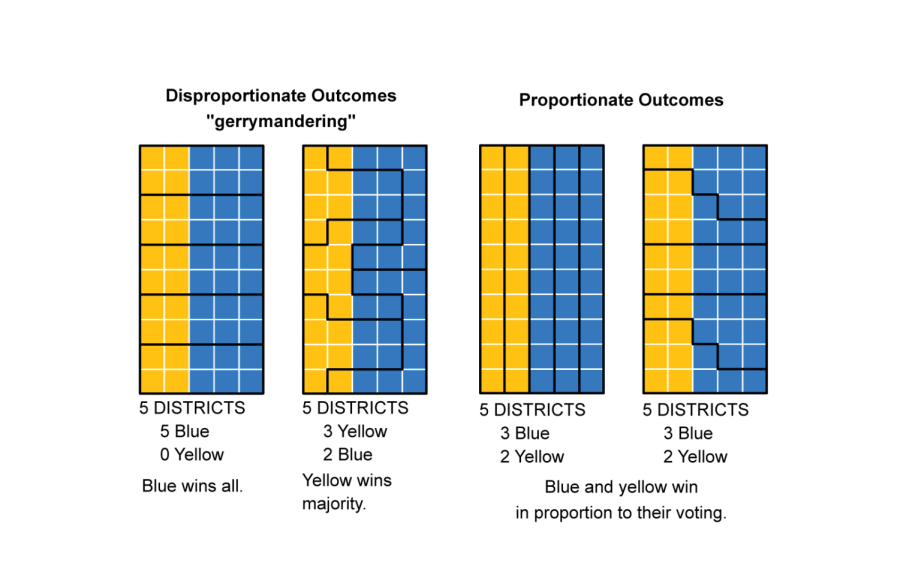What about gerrymandering?
Protasiewicz said she’d address the decade-old problem
Courtesy of Wikimedia – By manipulating district lines, parties can gain voting advantages in a state. Protasiewicz, who won her Wisconsin Supreme Court seat on April 4, said that she’s in favor of reexamining district maps.
April 12, 2023
After Justice Janet Protasiewicz’s victory in the Wisconsin Supreme Court election, there is now a liberal swing in the court allowing it to take on her campaign goal of addressing gerrymandering within Wisconsin.
Gerrymandering is the practice of manipulating boundaries of voting districts in order to achieve better results for a party, resulting in voters of an opposing party to be under-represented.
During her campaign, Protasiewicz said that she was in favor of reexamining district maps.
UW Oshkosh political science professor James Krueger said that the state of Wisconsin’s voting districts are poor compared to the rest of the nation.
“Wisconsin has one of the most gerrymandered set of maps for the State Assembly and Senate, as well as the House of Representatives districts in the United States,” he said. “Most experts compare the percentage of votes received by a party to the number of seats they attain in a legislative body to determine the efficiency of a set of maps. Wisconsin has had among the least efficient maps for these offices in the past five election cycles and they’re getting worse.”
Another UWO political science professor, David Siemers, said the history of the current maps are the result of a legislative failure and Supreme Court agreement.
“Legislative district lines are typically the result of laws produced by the legislative and executive branch together,” he said. “However, the recently adopted legislative district lines are a result of a state Supreme Court decision because the Republican-dominated legislature and Democratic Gov. Evers could not come to agreement on new lines.”
Siemers said the court’s choice was to make the decision that would make the fewest changes to the 2012 map, which leaned favorably toward the Republicans. Their choice was the one submitted by the Republican legislature.
Siemers said that a decision to change the maps will not be taken lightly by the court.
“If the court decides to throw out those maps now, all it is saying is that its prior decision was wrong,” he said. “Courts don’t lightly reverse their prior decisions, but it happened earlier this year to Roe v. Wade, and the state Supreme Court might do the same to its own decision to adopt the Republican legislative district maps.”
Krueger said the effects of these districts is an overrepresentation of Republicans, which can cause non-Republican voters to give up on voting efforts.
“That means Republicans are overrepresented in office compared to their share of the vote,” he said. “Elections are less competitive as the margin for winners exceeds 7.5%. The follow-on effect here is that turnout can decline as elections become uncompetitive.”
Despite her victory, Protasiewicz is unable to lead the Court to rule on the issue of gerrymandering unless a case is presented regarding more efficient maps. Krueger said that in the event of a ruling, it could be appealed to the U.S. Supreme Court, making possible action on gerrymandering difficult.
“It would be fair to assume (as happened in the last redistricting cycle in Wisconsin) that any ruling could also be appealed to the U.S. Supreme Court,” he said. “Recent history there indicates that the U.S. Supreme Court is willing to overrule decisions from the Wisconsin Supreme Court, as they did in 2022 after the Wisconsin court sided with the Evers administration concerning the drawing of some legislative districts.”
Krueger said that action may be arduous, and that many more factors will be in play than the latest election.
“There are many ‘ifs’ in that story,” he said. “When does a case arise from litigants who have standing? Does the decision support fairer maps? Does the decision get appealed? Does the U.S. Supreme Court take the case? Justice Protasiewicz’s election is likely to shift answers to the first two questions toward fairer maps, but it doesn’t affect the latter two questions.”
As a nation, not much precedent has been set on the matter as states have their own procedures when addressing redistricting, making the issue a unique one. Krueger said the use of politician-designed maps results in incumbent-favored victories.
“Keep in mind that states redistrict many different ways,” he said. “Some allow the legislature or governor or both in their state to have a role. These maps tend to serve the interests of one party or (when the government is divided among the parties) protect incumbents.”
Krueger said that in states where they adopt a nonpartisan approach utilizing the Voting Rights Act, maps are better for citizens.
“Other states rely on nonpartisan commissions that draw maps exclusively on the basis of the criteria laid out by the Voting Rights Act and the U.S. Supreme Court,” he said. “Those maps tend to be more efficient and therefore fairer.”














